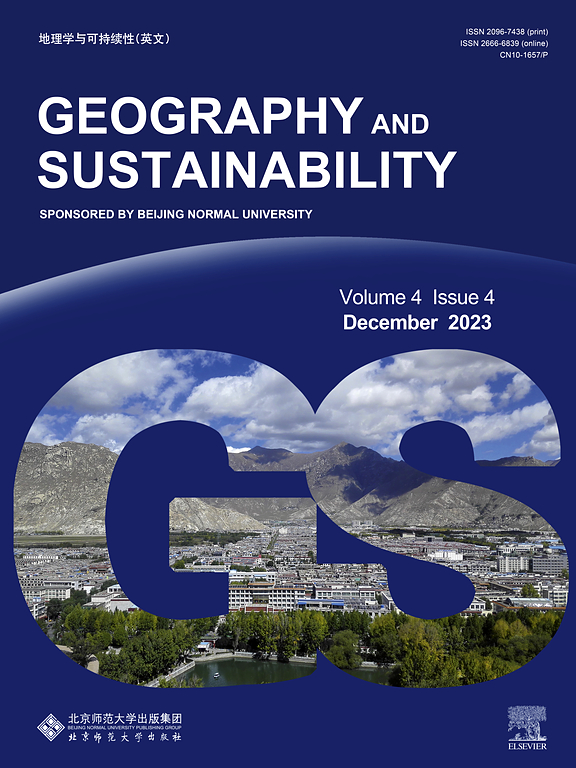推进青藏高原保护区生物多样性保护气候智慧型战略
IF 8
1区 环境科学与生态学
Q1 GEOGRAPHY, PHYSICAL
引用次数: 0
摘要
青藏高原是丰富的高原物种基因库,也是全球生物多样性保护的重要焦点。作为气候敏感地区,气候变化的影响导致栖息地丧失、种群灭绝和生态失衡,对现有保护区的持续有效性提出了巨大挑战。尽管近几十年来在物种分布、栖息地变化评估和保护区效率评估方面取得了实质性进展,但缺乏对所有受保护物种的全面评估,阻碍了保护策略的实施。本研究收集了137,856个观测数据,涵盖2,605个物种,并利用MaxEnt模型模拟了未来情景下濒危物种的分布格局和适宜栖息地的变化。我们进一步提出了一种气候智能方法来优化保护区边界以应对气候变化。结果表明:(1)青藏高原共有濒危物种2605种,占全国濒危物种目录总数的34.04%;(2)青藏高原目前的高适应生境仅占高原面积的7%,气候变化情景下的保护效率变化不大(增加0.50%);(3)纳入气候变化影响的保护区边界调整效率平均提高20.52%。本文提出的方法对青藏高原濒危物种的保护具有重要意义,对世界类似地区具有重要意义。本文章由计算机程序翻译,如有差异,请以英文原文为准。

Advancing a climate smart strategy for biodiversity conservation in protected areas on the Qinghai-Xizang Plateau
The Qinghai-Xizang Plateau serves as an extensive gene pool for plateau species and a crucial focal point for global biodiversity conservation. Being a climate-sensitive region, the impacts of climate change have led to habitat loss, population extinction, and ecological imbalances, posing formidable challenges to the sustained effectiveness of existing protected areas. Despite substantial advancements in understanding species distribution, assessing habitat changes, and evaluating the efficiency of protected areas in recent decades, comprehensive evaluations encompassing all protected species are lacking, impeding conservation strategies. In this study, we gathered 137,856 observations, encompassing 2,605 species, and utilized the MaxEnt model to simulate changes in the current distribution patterns of endangered species and suitable habitats under future scenarios. We further proposed a climate smart approach to optimize the boundaries of protected areas in response to climate change. Key findings indicate that (1) the Qinghai-Xizang Plateau harbors 2,605 endangered species, constituting 34.04 % of the total endangered species catalog in China; (2) current high-adaptation habitats of Qinghai-Xizang Plateau cover a mere 7 % of the plateau, showing minimal alteration in protected efficiency under climate change scenarios (0.50 % increase); (3) incorporating the effects of climate change in adjusting protected area boundaries enhances their efficiency by an average of 20.52 %. Our proposed methodology holds promise for safeguarding endangered species on the Qinghai-Xizang Plateau and offers significant implications for analogous regions worldwide.
求助全文
通过发布文献求助,成功后即可免费获取论文全文。
去求助
来源期刊

Geography and Sustainability
Social Sciences-Geography, Planning and Development
CiteScore
16.70
自引率
3.10%
发文量
32
审稿时长
41 days
期刊介绍:
Geography and Sustainability serves as a central hub for interdisciplinary research and education aimed at promoting sustainable development from an integrated geography perspective. By bridging natural and human sciences, the journal fosters broader analysis and innovative thinking on global and regional sustainability issues.
Geography and Sustainability welcomes original, high-quality research articles, review articles, short communications, technical comments, perspective articles and editorials on the following themes:
Geographical Processes: Interactions with and between water, soil, atmosphere and the biosphere and their spatio-temporal variations;
Human-Environmental Systems: Interactions between humans and the environment, resilience of socio-ecological systems and vulnerability;
Ecosystem Services and Human Wellbeing: Ecosystem structure, processes, services and their linkages with human wellbeing;
Sustainable Development: Theory, practice and critical challenges in sustainable development.
 求助内容:
求助内容: 应助结果提醒方式:
应助结果提醒方式:


